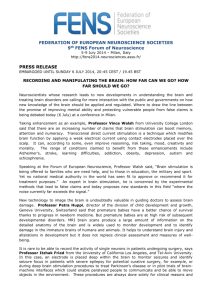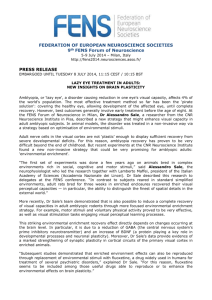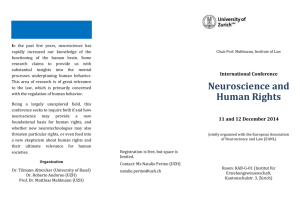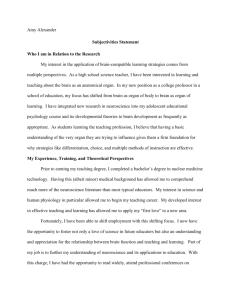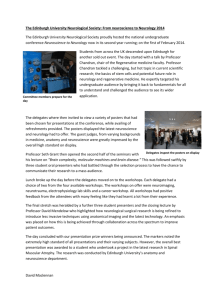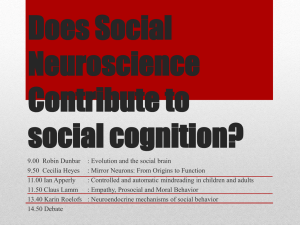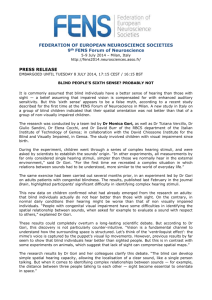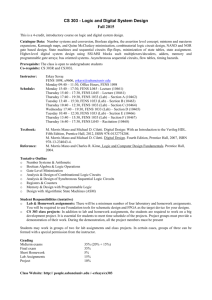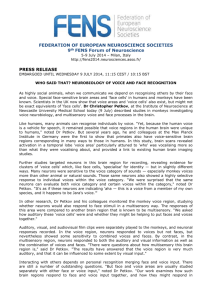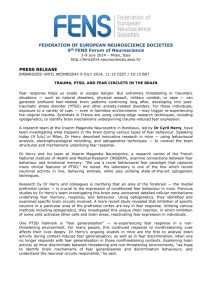`oops` centre - 9th FENS Forum of Neuroscience
advertisement
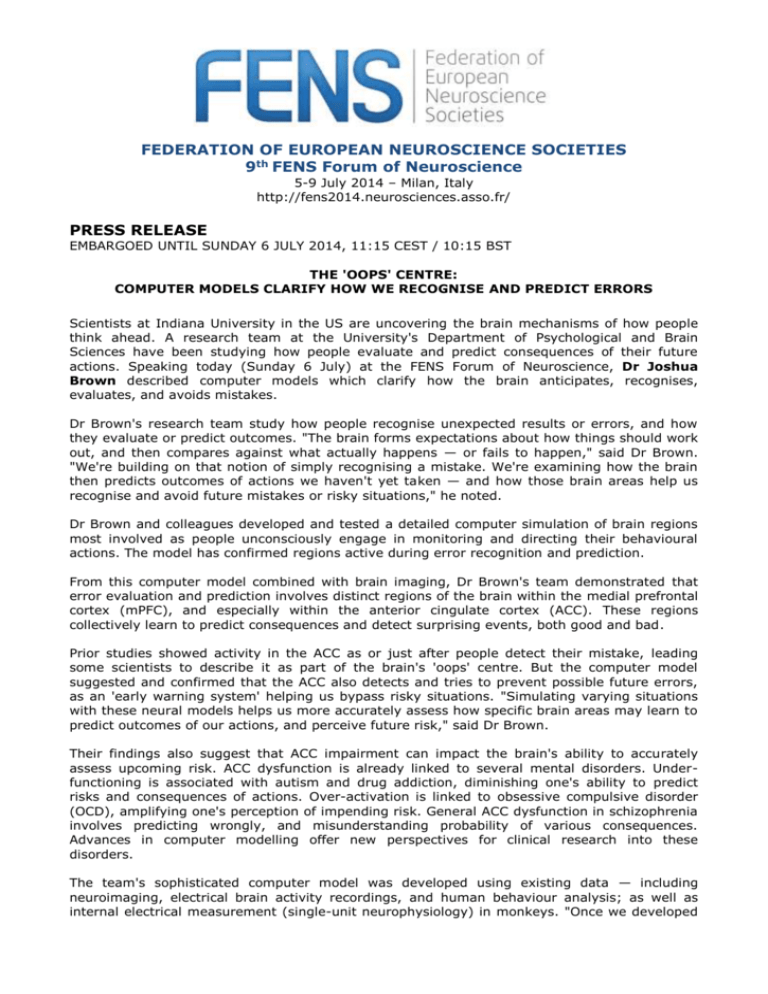
FEDERATION OF EUROPEAN NEUROSCIENCE SOCIETIES 9th FENS Forum of Neuroscience 5-9 July 2014 – Milan, Italy http://fens2014.neurosciences.asso.fr/ PRESS RELEASE EMBARGOED UNTIL SUNDAY 6 JULY 2014, 11:15 CEST / 10:15 BST THE 'OOPS' CENTRE: COMPUTER MODELS CLARIFY HOW WE RECOGNISE AND PREDICT ERRORS Scientists at Indiana University in the US are uncovering the brain mechanisms of how people think ahead. A research team at the University's Department of Psychological and Brain Sciences have been studying how people evaluate and predict consequences of their future actions. Speaking today (Sunday 6 July) at the FENS Forum of Neuroscience, Dr Joshua Brown described computer models which clarify how the brain anticipates, recognises, evaluates, and avoids mistakes. Dr Brown's research team study how people recognise unexpected results or errors, and how they evaluate or predict outcomes. "The brain forms expectations about how things should work out, and then compares against what actually happens — or fails to happen," said Dr Brown. "We're building on that notion of simply recognising a mistake. We're examining how the brain then predicts outcomes of actions we haven't yet taken — and how those brain areas help us recognise and avoid future mistakes or risky situations," he noted. Dr Brown and colleagues developed and tested a detailed computer simulation of brain regions most involved as people unconsciously engage in monitoring and directing their behavioural actions. The model has confirmed regions active during error recognition and prediction. From this computer model combined with brain imaging, Dr Brown's team demonstrated that error evaluation and prediction involves distinct regions of the brain within the medial prefrontal cortex (mPFC), and especially within the anterior cingulate cortex (ACC). These regions collectively learn to predict consequences and detect surprising events, both good and bad. Prior studies showed activity in the ACC as or just after people detect their mistake, leading some scientists to describe it as part of the brain's 'oops' centre. But the computer model suggested and confirmed that the ACC also detects and tries to prevent possible future errors, as an 'early warning system' helping us bypass risky situations. "Simulating varying situations with these neural models helps us more accurately assess how specific brain areas may learn to predict outcomes of our actions, and perceive future risk," said Dr Brown. Their findings also suggest that ACC impairment can impact the brain's ability to accurately assess upcoming risk. ACC dysfunction is already linked to several mental disorders. Underfunctioning is associated with autism and drug addiction, diminishing one's ability to predict risks and consequences of actions. Over-activation is linked to obsessive compulsive disorder (OCD), amplifying one's perception of impending risk. General ACC dysfunction in schizophrenia involves predicting wrongly, and misunderstanding probability of various consequences. Advances in computer modelling offer new perspectives for clinical research into these disorders. The team's sophisticated computer model was developed using existing data — including neuroimaging, electrical brain activity recordings, and human behaviour analysis; as well as internal electrical measurement (single-unit neurophysiology) in monkeys. "Once we developed the model, we forced it to make predictions about brain activation patterns in various experiments. Then we tested and confirmed these predictions with actual study data," said Dr Brown. "Effectively, computer simulation helped us 'predict' the neural mechanisms of human prediction." The human data his team used derived from a series of experiments examining neural activity while predicting and evaluating outcomes. Participants responded to cues on a computer screen, making either one or two actions, and then predicting their action's result. Researchers controlled the degree to which the actual outcomes differed from participants' predicted outcomes. In recent years, computer modelling has emerged as a valuable tool enhancing understanding of the brain. "Our research demonstrates that computer models can boost research capability and generate valuable findings," said Dr Brown. "By assembling disparate data with theory, we're able to better test and demonstrate the accuracy of those theories." Dr Brown believes that for conceptualising complex brain mechanisms, computational neural models offer a useful way forward. END Abstract Reference R10209: Cognitive control as a process of prediction and evaluation Symposia S08: The hedonistic brain: learning, predicting and decision making Contact FENS Press Office and all media enquiries: Elaine Snell, Snell Communications Ltd, London UK (English language) tel: +44 (0)20 7738 0424 or mobile +44 (0)7973 953 794 email: Elaine@snell-communications.net Mauro Scanu (Italian language) tel: +39 333 161 5477 email: press.office@fens.org Dr Joshua Brown jwmbrown@indiana.edu NOTES TO EDITORS The 9th FENS Forum of Neuroscience, the largest basic neuroscience meeting in Europe, organised by FENS and hosted by the The Società Italiana di Neuroscienze (SINS) (Italian Society for Neuroscience) will attract an estimated 5,500 international delegates. The Federation of European Neuroscience Societies (FENS), founded in 1998, aims to advance research and education in neuroscience, representing neuroscience research in the European Commission and other granting bodies. FENS represents 42 national and mono-disciplinary neuroscience societies with close to 23,000 member scientists from 32 European countries. http://fens2014.neurosciences.asso.fr/ Further Reading (Brown) Distinct regions of anterior cingulate cortex signal prediction and outcome evaluation. A Jahn, DE Nee, WH Alexander, JW Brown. NeuroImage. July 2014; Vol. 95: 80-89. DOI: 10.1016/j.neuroimage.2014.03.050 Medial prefrontal cortex as an action-outcome predictor. WH Alexander, JW Brown. Nature Neuroscience. 2011; 14(10): 1338-44. DOI: 10.1016/j.neuron.2012.12.002 The neural basis of predicting the outcomes of imagined actions. A Jahn, DE Nee, JW Brown. Frontiers in Decision Neuroscience. 2011; 5: 128. DOI: 10.3389/fnins.2011.00128
